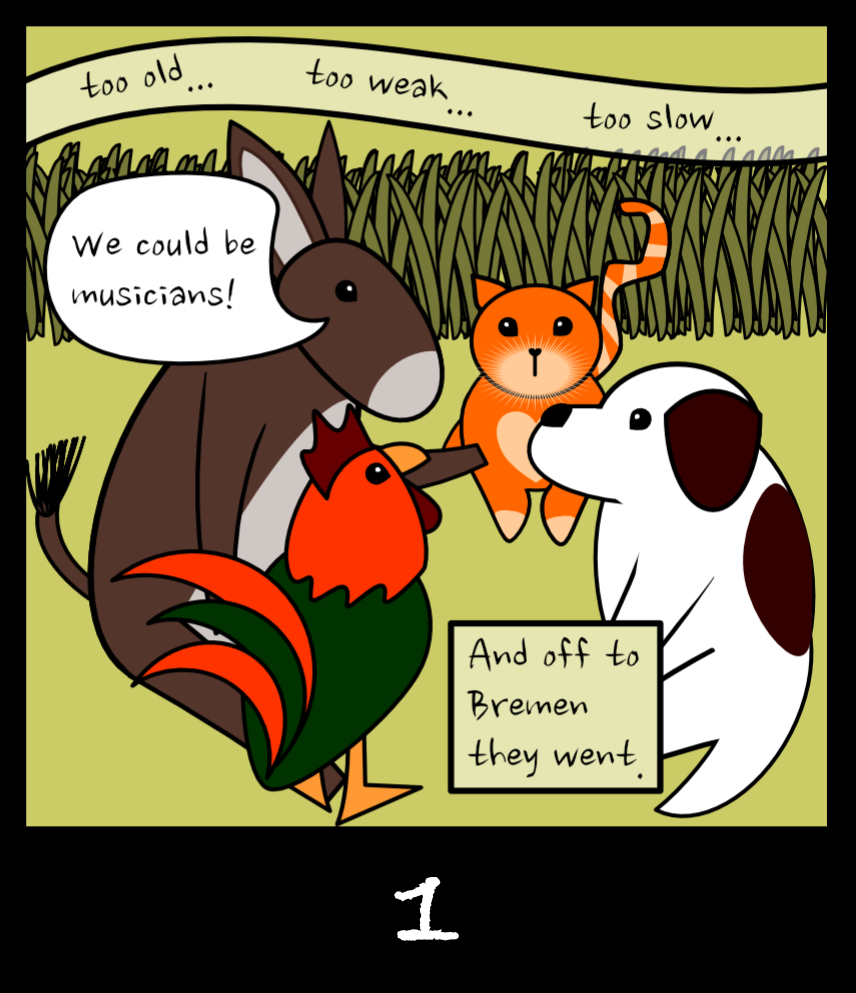
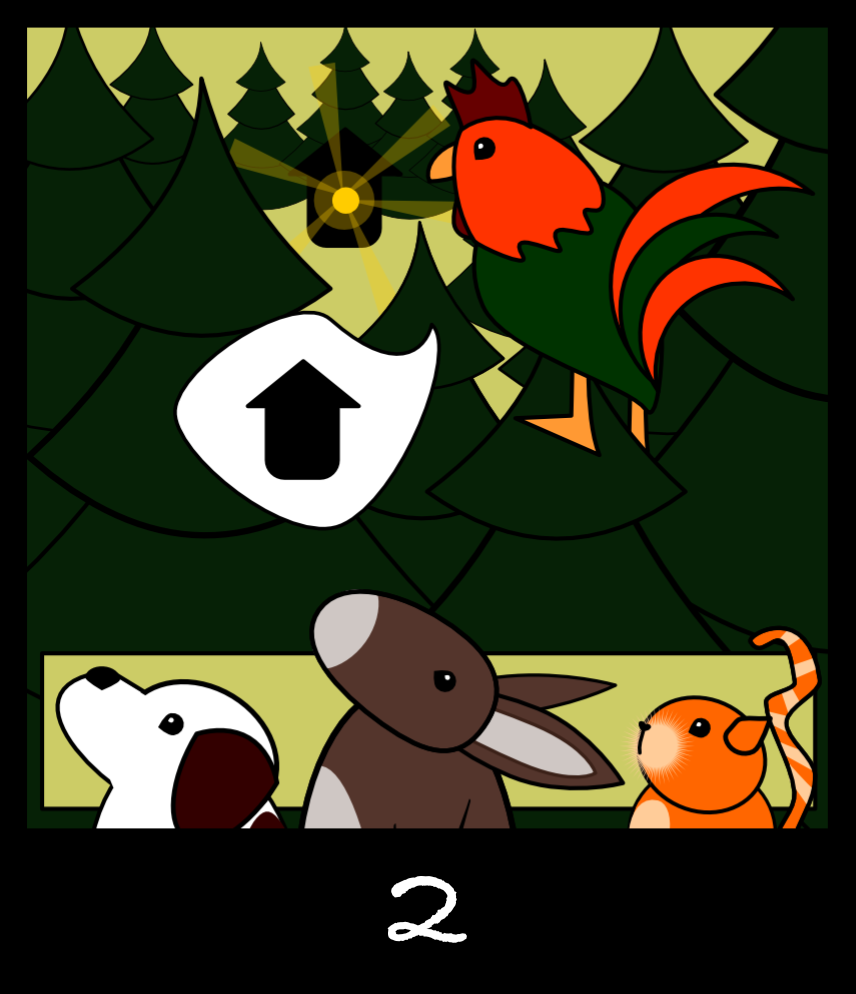
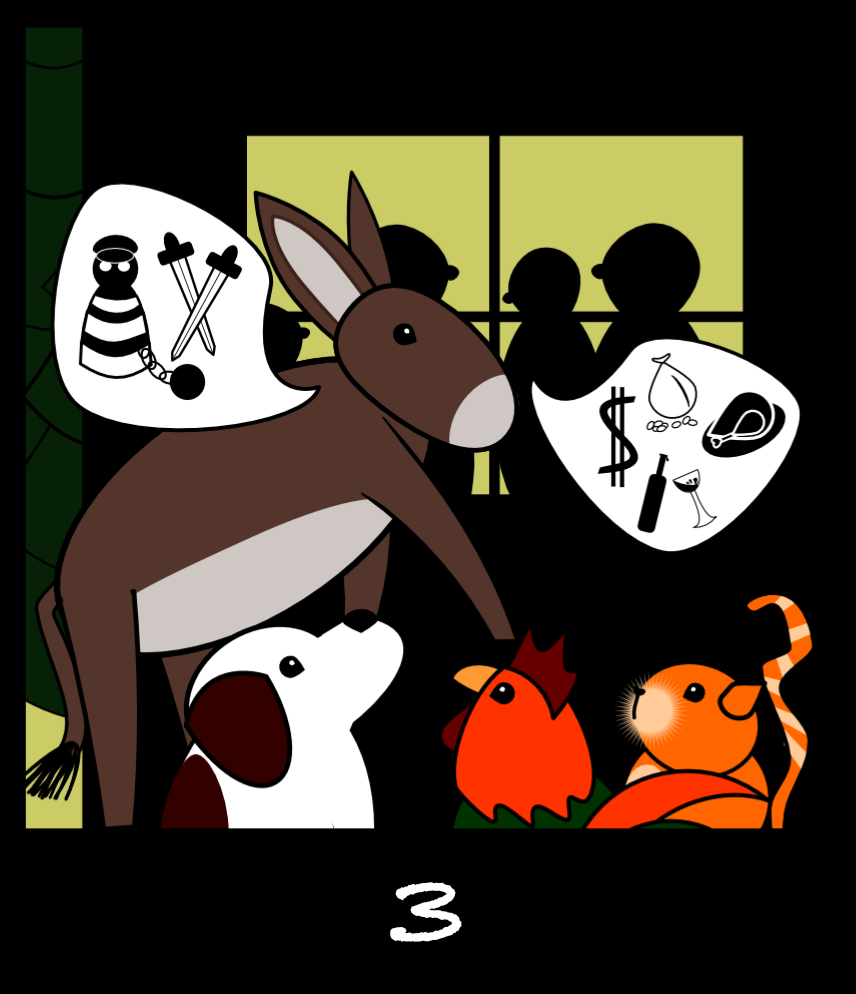

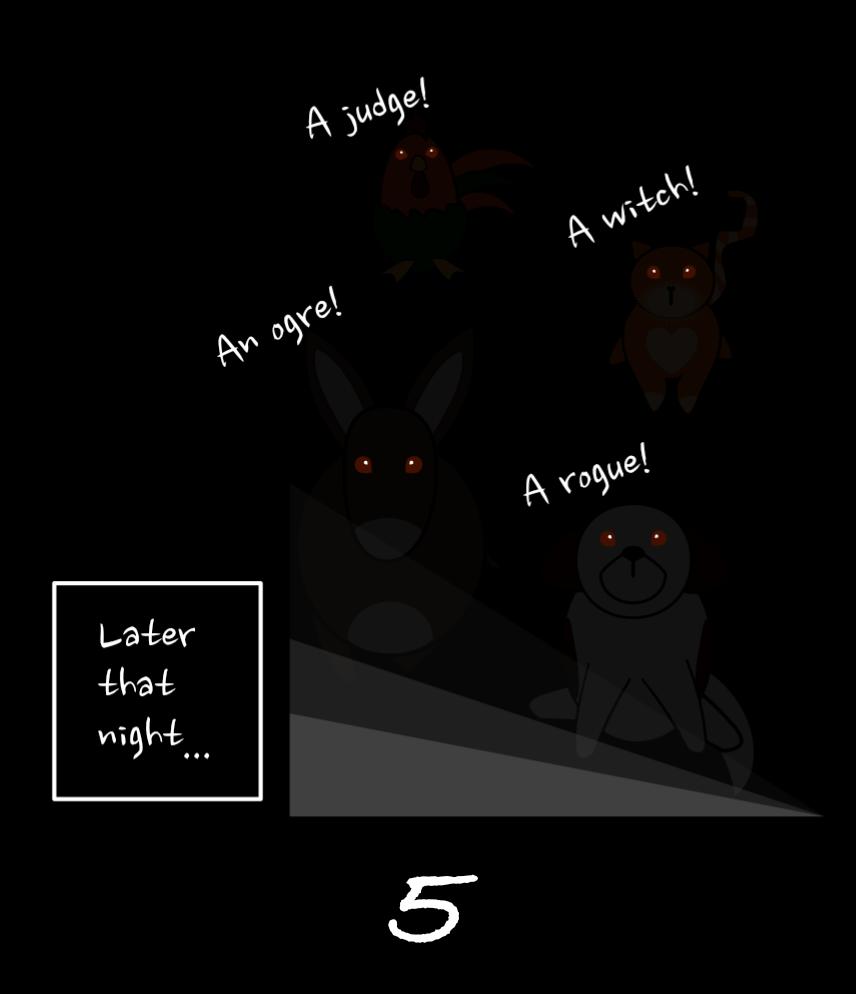
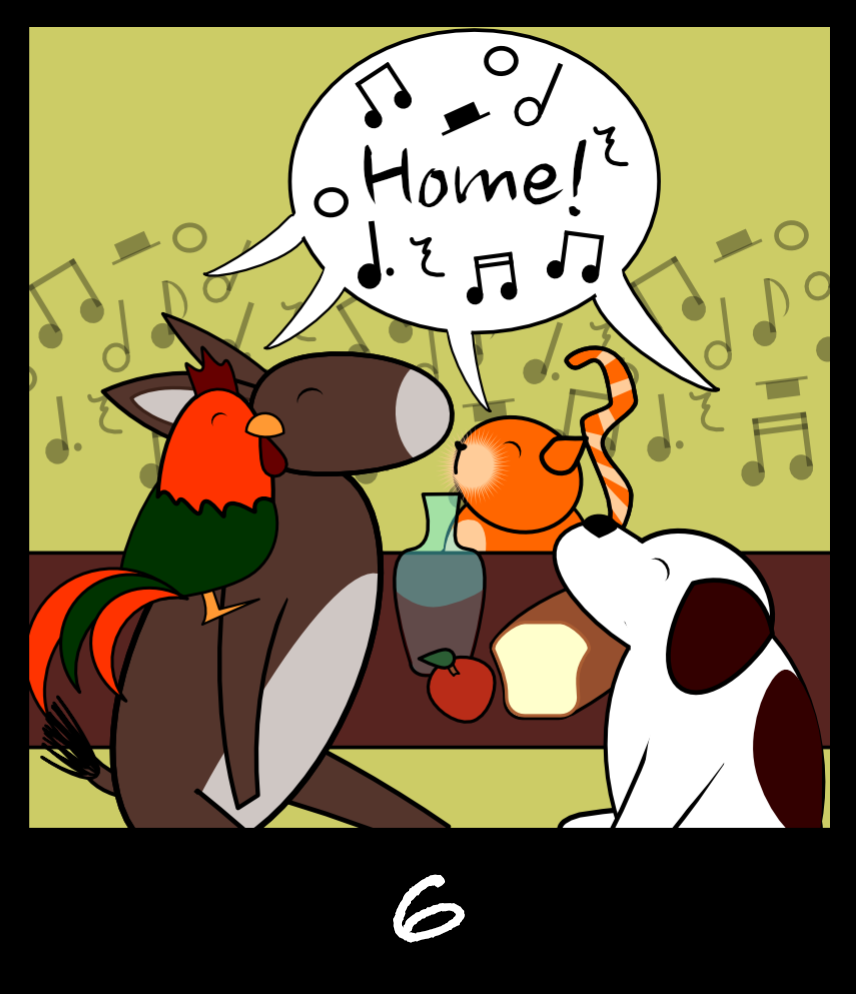
Read by Erin. Audio length: 1:10.
Read by Erin. Audio length: 2:28.
A donkey, a cat, a dog, and a rooster meet one another while journeying along a road. All four find out that they used to be in service to humans, but the humans deemed them too old, and planned to kill them—so the animals ran away. After meeting one another, they decide that they will journey to a town called Bremen and become musicians.
Four animals sit together in a grassy field, talking.
Four animals sit in a circle in a grassy field: a donkey, a cat, a dog, and a rooster. A banner above them reads "Too old... too weak... too slow." The donkey then gets an idea represented by a speech bubble that says, "We could be musicians!" A text box at the bottom of the frame reads, "And off to Bremen they went."
At first glance, the animals might seem young because of how brightly colored they are: the cat is orange, the rooster red and green, the donkey and dog richly spotted in brown, black, and white. But closer inspection shows signs of age: the cat's tail is crooked, the donkey's tail frayed, and the dog's posture is slumped. Despite these signs of age, their faces are eager and expectant. They have just heard the donkey's suggestion that they become musicians, an idea that will re-orient each of them away from human servitude and toward self-determination. Seated in a close circle, their intimacy and ability to cooperate are already evident.
AD is entangled with embodiment in various ways, including not only the bodies of those in the story, but also the body of the describer as it is projected verbally (sometimes in written form, sometimes in audio). The narrator of this illustration is extradiegetic: they exist outside the frame of the story, and their body is also outside the frame of the illustration. Other bodies, too, are not represented corporeally but rather through text: the animals' former owners speak in the banner text at the top, saying "too old, too weak, too slow." For more on this, go to Embodiment.
Read by Erin. Audio length: 2:33.
The animals have reached a forest and decide to camp for the night. The rooster flies to the top of a tree and prepares to make his bed there. However, he sees a light shining in the distance, and calls out to his companions, "I think I see a house!"
A rooster in a tree spies a house in the distance.
The rooster perches at the top of a tree, spotting a brightly lit house in the distance. The rooster's speech bubble contains an image of the house; at the foot of the tree, the dog, donkey, and cat all look up expectantly.
A red-and-green rooster perches in a pine tree, looking over a great distance toward a clearing in the forest. In the middle of the clearing stands a house with a light shining from its windows. Far below the rooster's tree, the dog, donkey, and cat look up, listening to their friend's report. The rooster is telling them about the house he sees.
What Sean Zdenek (2011) has termed "real estate" in the context of caption studies applies to AD as well. For example, in the interpretive description above, the describer chooses to begin with the rooster—arguably the most prominent figure in the illustration—then to follow the rooster's gaze to the house in the distance. The description then moves back toward the viewer and down, taking in the animals waiting at the foot of the tree. The last thing described is the rooster's speech. The description unfolds sequentially (whether the language is accessed visually or aurally), while the action in the story is simultaneous. Furthermore, the arrangement of elements in a description is always a choice on the part of the describer, and those choices have material consequences. For example, as Stephanie Kerschbaum (2013) has pointed out in Composing Access, if a presenter shows an image that makes most of the audience laugh, the presenter should describe it as soon as possible. Otherwise, audience members who do not have visual access to the slide are left out of the joke for an unspecified period of time. Yet it's not always easy to figure out just where and when to include a description, nor how to arrange information within a description. For more on this, go to Arrangement.
Read by Erin. Audio length: 2:46.
The animals leave their camping spot and make their way toward the light, until they arrive at a brightly lit house. As the only one tall enough, the donkey steps up to the window and peers through. He says to the cat, dog, and rooster, "I see a table covered with good things to eat and drink, and robbers sitting at it enjoying themselves."
A donkey peering in a window describes robbers enjoying a feast.
The donkey peers through the window of a house at a group of shadowy human silhouettes. The donkey's speech bubble contains images of a robber, weapons, money, gold coins, and food and drink. The dog, rooster, and cat all look up expectantly, listening to the donkey's description.
In this narrative moment, the donkey's and rooster's roles are reversed: the donkey is the only one tall enough to see through the window, so he uses his height to peer inside and describe the scene to his shorter companions. The donkey reports that he sees a table covered with good things to eat and drink, and—quoting from the source text of the fairy tale—"robbers" (Räuber) (Grimm & Grimm, n.d.). Like the cat, dog, and rooster, the readers narratively rely on the donkey's description to interpret the interior scene and fill in the details. The illustration offers some deliberately archaic visual cues to help the audience pick up on the labeling of the humans in the house as "robbers"—weapons, gold coins, and a ball and chain.
The reference to "robbers" appears twice in this section of the fairy tale. First, the extradiegetic narrator stated that the animals have come to "a well-lighted robbers' house." Then, the donkey repeats that the house's inhabitants are robbers in his statement to his companions. In both cases, the reader of the fairy tale is dependent upon someone else's description to understand what's going on. Neither description offers any information to indicate the source of the assumption that these are robbers. However, from a narrative point of view, it's important that the inhabitants of the house be villainous in some way; otherwise, the animals (the heroes) would not be justified in stealing from them (which happens later in the tale). AD often breaks the narrative frame for the purpose of enhancing access. For example, in conference access guides, a picture of an elevator might be accompanied by information that's outside the literal frame of the image (for example, a note that the elevator moves fast and might be difficult to manage for those with vertigo or balance issues). For more on this, go to Frame.
Read by Erin. Audio length: 2:30.
The animals discuss how to drive away the robbers, and arrive at a plan: They will make themselves appear larger, then burst in with a great noise. The donkey places his hooves upon the window-ledge, the hound jumps on the donkey's back, the cat climbs upon the dog, and the rooster perches on the cat. Once arranged, they burst in, making music at the top of their lungs. The robbers flee in fright, and the animals sit down happily at the table to eat.
Four animals charge toward the viewer, making loud noises.
Inside the house, the donkey, dog, cat, and rooster burst through the window, coming straight at the viewer with paws raised and wings spread. Text banners read: "They burst in, making music at the top of their lungs."
Inside the house, the donkey, dog, cat, and rooster burst through the window, coming straight at the viewer with paws raised and wings spread. The narrator, represented in a text banner, stated: "They burst in, making music at the top of their lungs." Curved lines around the animals indicate that their sounds are loud and cacophonous. The robbers' shock and fear can be felt through how close the animals are to the viewer, and through the crowded frame of the image, in which paws, claws, narrative language, and the animals' own voices all mingle together. In conventional illustrations of "The Bremen Town Musicians," the four animals are often shown in a neat vertical stack. This illustration emphasizes the chaos of the moment, and the way the animals tumble apart as they plunged through the window.
This moment in the story is especially compelling to us because not only are we working with specific tools to create these illustrations and their descriptions, but the animals themselves, within the frame of the story, are using tools in inventive ways to achieve their ends. In this case, the tools they use are entwined with their embodiment—they use their cooperatively-formed stature and their voices to chase the robbers away. This sort of improvisational tool-using has been theorized by Aimi Hamraie (2017) as "knowing-making" and by Jay Timothy Dolmage (2014) as mētis. For more on this, go to Tools.
Read by Erin. Audio length: 3:11.
The robbers regroup in the forest nearby, and one volunteers to go back to the house to find out who had taken it over. He sneaks into the kitchen, where all is quiet and dark except for the cat's glowing eyes. The robber believes the cat's eyes are coals, and holds out a lit match to try to light them—but at this, the cat leaps into his face, spitting and clawing. The robber flees toward the back door, where the dog springs up and bites his leg. Now at full speed, the robber dashes across the clearing, where the donkey kicks him as the rooster crows shrilly. Back in the forest, panting, the robber reports to his companions: "There is a horrible witch sitting in the house, who spat on me and scratched my face with her long claws. And by the door stands a man with a knife, who stabbed me in the leg. And in the yard there lies a black monster, who beat me with a wooden club. And above, upon the roof, sits the judge, who called out, bring the rogue here to me. So I got away as well as I could."
A dark room with four pairs of red eyes peering from the gloom.
A text box reads "Later that night..." The house is dark, with just a crack of light from the open door. Four shapes lurk in the darkness, barely visible except for their glowing red eyes. A textual exclamation looms above each shape: "A judge! An ogre! A witch! A rogue!"
A text box reads "Later that night..." The house is dark, with just a crack of light from the open door. Four shadowy figures with glowing red eyes lurk in the darkness, forming the outlines of the donkey, the dog, the cat, and the rooster. A textual exclamation looms above each shape: "A judge! An ogre! A witch! A rogue!" Because the exclamations are not attached to the shadowy images with comment bubbles, we can infer that this is someone else's speech—in this case, the robber, as he flees what he believes are a witch, a man with a knife, a monster with a club, and a judge. Although the robber encountered each animal in a different area around the house, this illustration shows the animals closer together, emphasizing their menacing appearance and their collective effect.
Assumptions are one of the most difficult aspects of AD to manage. In this moment of the fairy tale, the robber's description shows that he assumes he encountered fearsome, armed opponents instead of aging farm animals. The consequence, within the story, is that (spoiler alert) the robbers never return to the house. But the consequences of poorly-thought-out assumptions in contemporary, real-world instances of AD can have more harmful consequences. For example, making assumptions about the genders or races of people in images can cause significant harm—and the development of facial-recognition software and "auto-description" tools has greatly expanded their reach. For more on this, go to Assumptions.
Read by Erin. Audio length: 2:16.
The robbers were so thoroughly frightened, they never came back again. And the house suited the animals so well, they decided to stay and make it their new home.
Four animals sing "Home!" together.
The animals sit together around the table, enjoying a feast with music. The rooster is perched on the donkey's shoulder as they sing together, "Home!"
Inside the house, now brightly lit, the four animals sit at a table, the rooster sitting on the donkey's shoulder. Musical notes and symbols fill the speech bubble and the image background. Over an apple, a loaf of bread, and a carafe of wine, they share a single celebratory speech bubble: "Home!" Although their initial goal was to go to Bremen and become town musicians, they found an alternative in this house and now describe it as their new home and the end to their journey. As cozy a scene as this might appear to be, it has troubling undertones, since "the animals must [be] mistaken as something they are not in order for a happy ending to take place" (Schmiesing, 2017, p. 176). Their utopian enclave exists only at the cost of deception.
Thickness is, in part, simply a matter of how long a description is. Alt text is designed as a genre to be brief, since its purpose is to allow readers who are not taking in the images visually to get a quick sense of what's pictured. A somewhat longer (but still brief) description, perhaps two or three sentences, might be used as a generic caption—for example, on Instagram. The "interpretive description," however, appears in many different contexts, and serves a variety of purposes. For example, a user on social media posting for a close group of friends might describe an image not only in terms of its visual features, but also in terms of context beyond the image's frame. Similarly, a museum's AD tours of artworks will often combine historical and political information with information about a work's visual appearance. For more on this, go to Thickness.